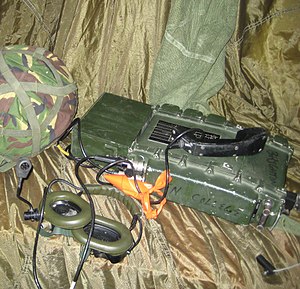Clansman
| Clansman | |
|---|---|

The PRC 320 HF Radio
|
|
| Type | Radio Communications System |
| Place of origin | United Kingdom |
| Service history | |
| In service | 1978 - 2000, 1982 - ~ 2004 |
| Used by | British Army and then Army Cadet Force |
| Wars |
Rhodesian War Falklands War Gulf War |
| Production history | |
| Designer | SRDE |
| Manufacturer | Racal, Marconi, Mullard Equipment Ltd (MEL) and Plessey |
| Produced | 1980s |
Clansman is the name of a combat net radio system (CNR) used by the British Army from 1976 to 2010.
Clansman was developed by the Signals Research and Development Establishment (SRDE) in the 1960s, to satisfy a General Staff Requirement (GSR) laid down in 1965. Most Clansman radio equipment was built by Racal, Mullard Equipment Ltd (MEL) and Plessey, although headsets and ancillaries were also produced by Amplivox, Marconi and others. Clansman represented a considerable advance over existing radios being offered to the Armed Forces at the time. It replaced the aging Larkspur radio system, and proved to be more flexible, reliable and far lighter. The technological advances achieved in the design of Clansman allowed the introduction of Single SideBand (SSB) operation and NarrowBand Frequency Modulation (NBFM) to forward area combat net radio for the first time.
Clansman was in use by British forces from the late 1970s and saw service in most recent UK military operations. It was replaced in the mid-2000s by the new Bowman communication system.
The Clansman family of Military Radio Sets comprises nine main radio units, operating in the High Frequency (HF), Very High Frequency (VHF) and the Ultra High Frequency (UHF) Radio Bands.
Models are designated "UK/PRC" or "UK/VRC", which stand for "United Kingdom / Portable Radio Communications" and "United Kingdom / Vehicle Radio Communications" respectively. The radios first came into service in the late 1970s at that time the main advantage of the Clansman radios was that they were all frequency synthesised (switched channels, as opposed to using a variable tuning scale for example). This provided frequency stability, obviating the need to tune the radio again, once a frequency was set. Previous UK military radios were much less stable, and had to be frequently tuned (or might need to be tweaked to "pull in" a weak signal).
...
Wikipedia
